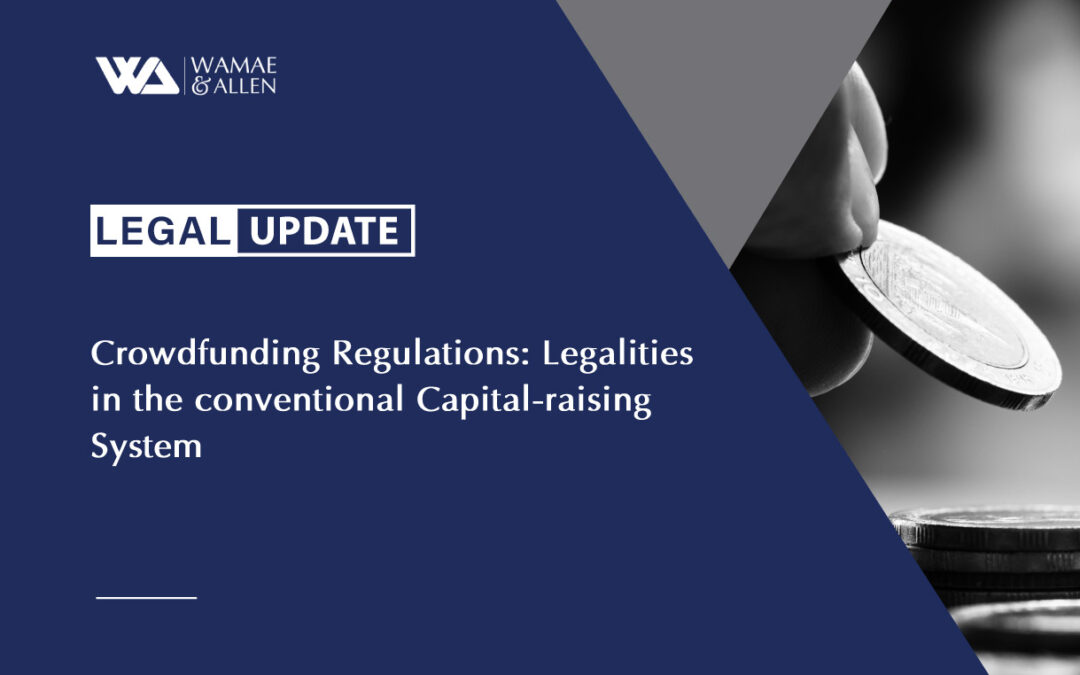- INTRODUCTION
- The everyday means of raising capital for business entities are through loans or shares as equity. However, with the continuous sophistication of the world, more vibrant and engaging ways have emerged, for instance, crowdfunding.
- The origins of crowdfunding can be traced back to a British Rock group, Marillion, that raised about US$ 60,000 in 1997 through the internet to back a U.S. tour. The phenomenon has grown ever since and has a rather satisfactory definition as raising funds online through communal funding of people or groups of people, “the crowd”
- It is a method of financing through which businesses can raise capital from a large number of people. In recent times and especially in Kenya, crowdfunding growth has greatly been enabled by the massive growth of the fintech industry.
- The growth in the sector, and in a bid to protect investors who invest through crowdfunding platforms characterized by intense lobbying over the years led to the gazettement of the Capital Markets (Investment-Based Crowdfunding) Regulations 2022 were gazetted on 25th October 2022 (hereinafter referred to as “the Regulations”). Simply, the regulations aim to control investment-based crowdfunding platforms in Kenya while protecting all the parties involved considering that crowdfunding is a high-risk investment method.
- The Regulations have been lauded in the fintech and startup industries. According to data by Statista, a company specializing in research, transaction value in the crowdlending (business) segment is projected to reach US$ 4,290,000 in 2023 in Kenya.
- KEY HIGHLIGHTS OF THE REGULATION
- The Regulation is only purposed at controlling investment-based crowdfunding. Simply, investment-based crowdfunding is a type of crowdfunding where investors invest in a business in exchange for equity in form of shares, debt securities and other investment instruments.
- Participants in the Crowdfunding Ecosystem
- Part III of the Regulation has designated two participants on a crowdfunding platform, that is, Issuers and Investors. An issuer is a company which issues the security or investment instrument, which is hosted on the crowdfunding platform for purposes of crowdfunding. An investor, in contrast, is any person or entity that seeks to make or has made an investment through a crowdfunding platform.
- Regulation 13 sets the minimum eligibility criteria for an issuer to engage in a crowdfunding platform. As a general rule, SMEs incorporated in Kenya with good corporate governance records and a minimum of two years operating track record are eligible to raise funds through a crowdfunding platform. Moreover, startups with a good operating track record and a good corporate governance track record are still eligible despite the former statement. This is a plausible provision as does not lock out any startup provided a good governance track record is proven.
- Under Regulation 14, the maximum cumulative amount of money a startup can raise in the year at Kshs. 100,000,000/-. However, a crowdfunding platform may apply to the Capital Markets Authority (hereinafter referred to as the “CMA”) for a no-objection where an issuer seeks to go beyond the set limit within the set duration.
- In addition to an entity that the CMA has blacklisted, publicly listed companies and their subsidiaries, entities with a poor governance record, and entities that intend to use the funds raised to provide loans or invest in other entities have been prohibited from raising money through crowdfunding platforms under Regulation 15.
- Investors on the other hand have been split into sophisticated and retail investors. Retail investors are however subjected to investment limits prescribed by the crowdfunding platform operator up to a maximum of Kshs. 100,000/-.
- Licensing Conditions
- Just like all regulated transactions and businesses in Kenya, crowdfunding companies must obtain licenses from the CMA. This has been entrenched under Regulation 2 of the Regulations. In making the application, Regulation 5 lists the documents to be submitted before the application can be considered by the CMA.
- It is worth noting that a company limited by shares is the only vehicle that can be licensed to undertake crowdfunding in Kenya. Further, the company must have a minimum paid-up share capital of Kenya shillings of five million and a minimum liquid capital of Kenya shillings ten million or eight percent of its liabilities, whichever is higher.
- Regulation 8 of the Regulations sets the criteria through which the CMA mirrors the applicant’s status before granting a crowdfunding license. A Crowdfunding company is mandated to pay a predetermined annual licensing fee for its operation within the country.
- On the other hand, if an applicant’s license application is rejected by CMA, the aggrieved applicant may appeal against such refusal to the Capital Markets Tribunal within fifteen days of communication of the decision.
- In a bid to protect investors and users, the Regulation expects a crowdfunding platform operator to issue a thirty days notice in writing to CMA if it intends to cease operations, who may then impose any terms and conditions to ensure an orderly cessation of business of the crowdfunding platform operator.
- Crowdfunding Operation and Transactions
- Under part IV of the Regulations, crowdfunding platform operators are mandated to develop standardized offering documents for entities offering securities and the same is to be submitted to CMA within forty-eight hours prior to its publication. The offering document shall be made available through the crowdfunding platform to the investors at least fourteen days before the commencement of the offer period.
- The issuer determines and is obligated to disclose to the investors the period in which the offer is to remain open and the threshold amount for the offer to be deemed a successful offer. An offer put may be withdrawn if it fails to meet the prescribed minimum threshold for the targeted amount. After the withdrawal of an offer, the Crowdfunding platform operator then refunds money to the investors within 48 hours, the costs of which are borne by the issuer. After this unfortunate event, the issuer may only commence a fresh crowdfunding offering after ninety days from the withdrawal.
- In a successful crowdfunding operation, the crowdfunding platform operator is mandated to make the funds available to the issuer within five business days after the close of the offer.
- Regulation 19(5) states that the contractual right of a cooling-off period should be included in the crowdfunding offer by the issuer, thereby allowing the investor to withdraw an offer or agreement to purchase the investment instrument by delivering a notice in the manner prescribed by the crowdfunding platform operator within forty-eight hours from the date of investments subscription. However, no withdrawal can be made after the close of the offer period.
- A prohibition is set against crowdfunding platform operators who are prohibited from raising their own funds through their own platform, offering investment advice, handling investor funds, promising a guaranteed return to investors or even guaranteeing an outcome of the offer to the issuer.
- Issuers have also been prohibited from hosting concurrent offers on multiple crowdfunding platforms.
- The Duties and Obligations of Crowdfunding Platforms in the Ecosystem
- Crowdfunding platforms must be cautious of their duties and obligations under the Regulations lest their licenses are restricted, revoked or even suspended in accordance with Regulation 11 of the Regulations.
- A discussion on duties and obligations herein is drawn from Part VI of the Regulations. A crowdfunding platform operator is obligated to provide information on how the platform operates, the users’ rights and responsibilities, eligibility criteria for prospective issuers and investors, investor education materials, complaint handling and dispute resolution procedures, disclaimers and limitation of liability, highlighting the platforms legal liability for damages incurred by its users and even the related fees and charges for using the platform.
- Crowdfunding companies are required to have custodial arrangements for their trust accounts, monitor and ensure compliance with its rules, take reasonable steps to prevent fraud, maintain a register and records of all investors and issuers, avail any relevant document or information to the investor upon request, comply with continuous reporting obligations, and even notify the CMA immediately of any material changes that may occur during operations which would affect its authorization and licensing.
- A cautionary statement is to be displayed by the Crowdfunding platform cautioning and/or advising investors that investing in the issuers hosted on the platform may be a high-risk investment and that they should be in a position to bear the risk associated with the loss of investment without undue hardship. The cautionary statement should further advise prospective investors to seek independent and informed financial advice before lending through the platform.
- The Crowdfunding platform has also been placed under the obligation of carrying out due diligence on prospective issuers and investors intending to use its platform. The due diligence cuts across background checks on the issuer and investor, level of sophistication of the investor, fitness and probity checks on the directors and management, information in the issuer’s disclosure documents lodged before they are made accessible to investors through the platform, and compliance with anti-money laundering rules in place.
- CRITICISM
- Concurrently raising money on different crowdfunding platforms
- The Regulation, particularly under Regulation 23(2), has blanketly limited a business’s ability to concurrently raise money through various crowdfunding platforms. This is might deal a low blow to the issuers who may want to raise different percentages of the same offering across different platforms in a bid to maximize their chances of raising the required capital. Setting up issuers to use a single crowdfunding platform at a given time is tantamount to setting them up for failure. The law should be flexible enough to allow startups to raise needed funds in various platforms at a go with specific percentage apportionments. The law should help businesses thrive, faster.
- Fundraising limits
- Regulation 14 has set the fundraising limit at Kshs. 100,000,000/- per year for a single issuer. As much as this is reasonable, the provision should be set on a rolling basis where the CMA adjusts the limit, not less frequently than once every five years, by notice published in the Gazette, to reflect any change in the Consumer Price Index, the economy, and the crowdfunding industry at large.
- Regulation of other types of crowdfunding
- There are no regulations for other types of crowdfunding including reward-based and donation based. As much as these types of crowdfunding operate in a different sphere from investment-based crowdfunding, Kenya’s relevant authorities including the Competition Authority (for reward-based crowdfunding) and the NGO Board (for donation-based crowdfunding) among others, should come up with regulations to govern these growing industries in Kenya, ultimately protecting the consumers and end users.
- CONCLUSION
- From the foregoing and true to Lawrence Lessig words, “Law and technology produce, together, a kind of regulation of creativity we’ve not seen before.”.
- Kenya has made great advancements in innovative financial services, such as mobile money platforms, and various microfinance models. Cambridge Centre for Alternative Finance reported that in the period 2013-2015, Kenya was one of the market leaders for crowdfunding and alternative financial models across Africa.
- Given the exponential growth of crowdfunding platforms over the last few years, regulation will go a long way in the protection of users and investors eventually bridging the gap of raising capital for startups and businesses in the new technological era.
This article is provided free of charge for information purposes only; it does not constitute legal advice and should be relied on as such. No responsibility for the accuracy and/or correctness of the information and commentary as set in the article should be held without seeking specific legal advice on the subject matter. If you have any query regarding the same, please do not hesitate to contact Conveyancing vide conveyancing@wamaeallen.com
 Loading...
Loading...
About the author
Academic Qualifications
ATP (Postgraduate Diploma), Kenya School of Law, 2019
LLB (Hons), Kenyatta University, 2016
Professional Qualifications
Member, Law Society of Kenya
Ogolla Omondi Elvis is an Associate in the Commercial, Conveyancing & Real EstateDepartment and specialises in banking & finance law, securitization, general property law,
company and corporate law, legal compliance, joint ventures, business formations and general commercial transactions.
He has a wealth of expansive experience, knowledge and essential comprehension of the legal frameworks relating to the property and commercial sector in Kenya.
Elvis has been involved in providing corporate and commercial advice to clients in a wide range of sectors.
Elvis further has an experience with fintech in their particular spaces.
-
Elvis Ogolahttps://wamaeallen.com/author/elvis-ogola/
-
Elvis Ogolahttps://wamaeallen.com/author/elvis-ogola/












